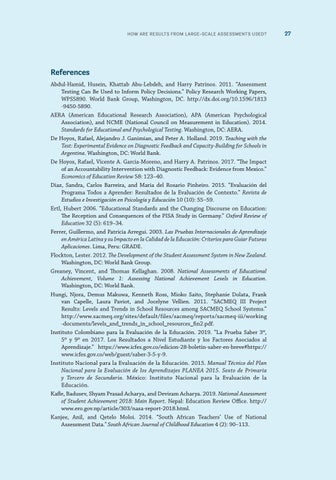How Are Results from Large-Scale Assessments Used?
References Abdul-Hamid, Husein, Khattab Abu-Lebdeh, and Harry Patrinos. 2011. “Assessment Testing Can Be Used to Inform Policy Decisions.” Policy Research Working Papers, WPS5890. World Bank Group, Washington, DC. http://dx.doi.org/10.1596/1813 -9450-5890. AERA (American Educational Research Association), APA (American Psychological Association), and NCME (National Council on Measurement in Education). 2014. Standards for Educational and Psychological Testing. Washington, DC: AERA. De Hoyos, Rafael, Alejandro J. Ganimian, and Peter A. Holland. 2019. Teaching with the Test: Experimental Evidence on Diagnostic Feedback and Capacity-Building for Schools in Argentina. Washington, DC: World Bank. De Hoyos, Rafael, Vicente A. Garcia-Moreno, and Harry A. Patrinos. 2017. “The Impact of an Accountability Intervention with Diagnostic Feedback: Evidence from Mexico.” Economics of Education Review 58: 123–40. Diaz, Sandra, Carlos Barreira, and Maria del Rosario Pinheiro. 2015. “Evaluación del Programa Todos a Aprender: Resultados de la Evaluación de Contexto.” Revista de Estudios e Investigación en Psicología y Educación 10 (10): 55–59. Ertl, Hubert 2006. “Educational Standards and the Changing Discourse on Education: The Reception and Consequences of the PISA Study in Germany.” Oxford Review of Education 32 (5): 619–34. Ferrer, Guillermo, and Patricia Arregui. 2003. Las Pruebas Internacionales de Aprendizaje en América Latina y su Impacto en la Calidad de la Educación: Criterios para Guiar Futuras Aplicaciones. Lima, Peru: GRADE. Flockton, Lester. 2012. The Development of the Student Assessment System in New Zealand. Washington, DC: World Bank Group. Greaney, Vincent, and Thomas Kellaghan. 2008. National Assessments of Educational Achievement, Volume 1: Assessing National Achievement Levels in Education. Washington, DC: World Bank. Hungi, Njora, Demus Makuwa, Kenneth Ross, Mioko Saito, Stephanie Dolata, Frank van Capelle, Laura Paviot, and Jocelyne Vellien. 2011. “SACMEQ III Project Results: Levels and Trends in School Resources among SACMEQ School Systems.” http://www.sacmeq.org/sites/default/files/sacmeq/reports/sacmeq-iii/working -documents/levels_and_trends_in_school_resources_fin2.pdf. Instituto Colombiano para la Evaluación de la Educación. 2019. “La Prueba Saber 3º, 5º y 9º en 2017. Los Resultados a Nivel Estudiante y los Factores Asociados al Aprendizaje.” https://www.icfes.gov.co/edicion-28-boletin-saber-en-breve#https:// www.icfes.gov.co/web/guest/saber-3-5-y-9. Instituto Nacional para la Evaluación de la Educación. 2015. Manual Técnico del Plan Nacional para la Evaluación de los Aprendizajes PLANEA 2015. Sexto de Primaria y Tercero de Secundaria. México: Instituto Nacional para la Evaluación de la Educación. Kafle, Badusev, Shyam Prasad Acharya, and Deviram Acharya. 2019. National Assessment of Student Achievement 2018: Main Report. Nepal: Education Review Office. http:// www.ero.gov.np/article/303/nasa-report-2018.html. Kanjee, Anil, and Qetelo Moloi. 2014. “South African Teachers’ Use of National Assessment Data.” South African Journal of Childhood Education 4 (2): 90–113.
27

